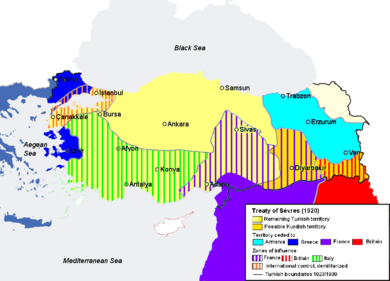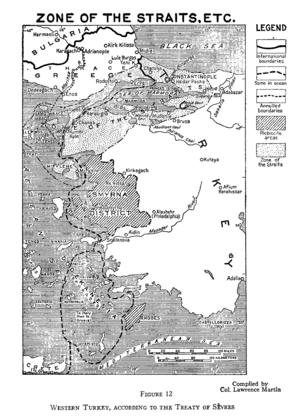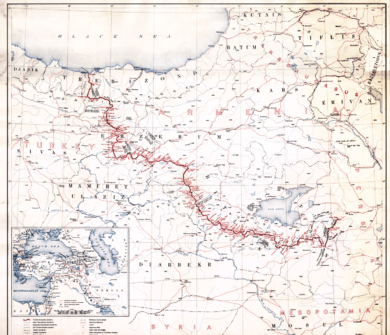Treaty of Sèvres facts for kids
| The Treaty of Peace Between the Allied Powers and the Ottoman Empire | |
|---|---|
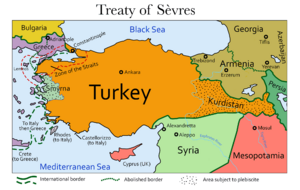
Partition of the Ottoman Empire according to the Treaty of Sèvres and the Greco-Italian treaty
|
|
| Signed | 10 August 1920 |
| Location | Sèvres, France |
| Condition | Ratification by Ottoman Empire and the four principal Allied Powers. |
| Signatories | 1. Principal Allied Powers Other Allied Powers
2. Central Powers |
| Depositary | French Government |
| Languages | French (primary), English, Italian |
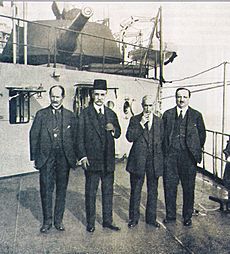
The Treaty of Sèvres (which in French is Traité de Sèvres) was an important agreement signed in 1920. It was made between the Allies of World War I and the Ottoman Empire. This treaty was one of several signed by the losing side (the Central Powers) after their defeat in World War I. The fighting had already stopped with the Armistice of Mudros.
The treaty was signed on August 10, 1920. The signing took place in a special room at the Sèvres porcelain factory in Sèvres, France.
The Treaty of Sèvres was the start of the splitting up of the Ottoman Empire. The treaty said that the Ottoman Empire had to give up most of its land where Turkish people did not live. This land was then given to the Allied countries to manage.
New areas were created in the Eastern Mediterranean. These included the British Mandate for Palestine and the French Mandate for Syria and Lebanon.
The terms of the treaty made many people in Turkey angry. This led to a strong feeling of Turkish nationalism. The leaders of the Grand National Assembly, led by Mustafa Kemal Pasha, took away the citizenship of those who signed the treaty. This anger started the Turkish War of Independence.
Later, a new treaty called the Treaty of Lausanne replaced the Treaty of Sèvres in 1923. This new treaty ended the conflict and led to the creation of the Republic of Turkey.
Contents
What the Treaty of Sèvres Said
The Treaty of Sèvres had many parts. It covered different topics about how the Ottoman Empire would be changed after World War I.
- Part I: The rules for the League of Nations, an international organization for peace.
- Part II: The new borders of Turkey.
- Part III: Political rules for the region.
- Part IV: How minority groups would be protected.
- Part V: Rules about the military, navy, and air force.
- Part VI: What to do with prisoners of war and graves.
- Part VII: Penalties for war crimes.
- Part VIII: Financial rules.
- Part IX: Economic rules.
- Part X: Rules for flying planes.
- Part XI: Rules for ports, waterways, and railways.
- Part XII: Rules about labor (work).
- Part XIII: Other general rules.
Who Signed the Treaty?
George Dixon Grahame signed for the United Kingdom. Alexandre Millerand signed for France. Count Lelio Longare signed for Italy.
Greece was an Allied power, but it did not agree with the borders drawn in the treaty. Greece never officially approved the treaty.
Three people signed for the Ottoman Empire:
- Ex-Ambassador Hadi Pasha
- Ex-Minister of Education Rıza Tevfik Bölükbaşı
- Second secretary of the Ottoman embassy in Bern, Reşat Halis
The Russian Soviet Federative Socialist Republic (Soviet Russia) was not part of this treaty. This was because they had already made their own peace agreement with the Ottoman Empire in 1918.
The Treaty of Versailles was signed with Germany before the Treaty of Sèvres. It canceled all German business deals and rights in the Ottoman Empire.
France, Britain, and Italy also signed a special agreement on the same day. This agreement confirmed Britain's oil and business rights. It also gave former German businesses in the Ottoman Empire to a joint company of the three countries.
The United States did not take part in dividing the Ottoman Empire. The US Senate did not want to take control over Armenia. The US wanted peace quickly and to be paid back for its war costs.
Treaty Rules and Changes
The treaty made Turkey lose a lot of land. It also set many rules for the land that remained part of Turkey.
Money Rules
The Allied powers would control the Ottoman Empire's money. They would approve the national budget and control financial laws. They would also fully control the Ottoman Bank.
The Ottoman Public Debt Administration, which managed the empire's debts, was changed. Now, only British, French, and Italian lenders would be part of it. The Ottoman Empire had borrowed money from other countries, mainly France, since the Crimean War (1854–1856).
Also, special economic rights called "capitulations" were brought back. These rights had been removed in 1914. They allowed foreign citizens to live and do business in the Ottoman Empire under their own laws.
The empire had to allow people, goods, and ships to travel freely through its land. Goods passing through would not have to pay customs taxes. Any future changes to taxes, customs, or loans would need the approval of the Allied financial group.
To stop Germany, Austria, Hungary, or Bulgaria from gaining economic power again, the treaty demanded that the empire sell the property of citizens from those countries.
Military Rules
The Ottoman Army was limited to only 50,700 soldiers. The Ottoman Navy could only have seven small ships (sloops) and six torpedo boats. The Ottoman Empire was not allowed to have an air force. A special group of Allied countries would watch to make sure these military rules were followed.
International Justice
The treaty also demanded that those responsible for the Armenian genocide be identified. Article 230 of the treaty required the Ottoman Empire to hand over people responsible for "massacres committed" during the war. However, the attempt to bring these war criminals to justice did not succeed. Those who planned the massacres were not brought to justice.
Foreign Influence Zones
Even in the land that remained Turkey's, some areas were declared "zones of influence" for Allied powers.
French Influence
France gained control over Syria and nearby parts of southeastern Anatolia. This included cities like Antep, Urfa, and Mardin. A large area, including Cilicia (with Adana, Diyarbakır) and parts of central Anatolia up to Sivas and Tokat, became a French zone of influence.
Greek Influence
The Greek government had already started to manage Smyrna (modern Izmir) in 1919. The treaty allowed Greece to administer the Smyrna area. However, the area officially remained under Turkish control. The treaty said that after five years, the people of Smyrna could vote to decide if they wanted to join Greece or stay with the Ottoman Empire.
Italian Influence
Italy officially took control of the Dodecanese Islands. These islands had been under Italian control since 1911. Large parts of southern and west-central Anatolia, including the port city of Antalya and Konya, were declared an Italian zone of influence. Italy had been promised the Antalya area in an earlier agreement.
Land Changes
The treaty greatly reduced the size of the Ottoman Empire.
Zone of the Straits
A special "Zone of the Straits" was planned. This zone included the Bosphorus, the Dardanelles, and the Sea of Marmara. Ships of all kinds, whether for trade or war, could pass freely through these waters. This meant the waters would be controlled by international groups. No acts of war could happen there, unless approved by the League of Nations.
Free Ports
Some important ports were to be made "free zones." This meant they would be open to all countries equally, especially for trade. These ports included Constantinople, Smyrna, Alexandretta, Haifa, Basra, Trabzon, and Batum.
Thrace
Eastern Thrace (a region in Europe), the islands of Imbros and Tenedos, and the islands in the Sea of Marmara were given to Greece. The waters around these islands were made international territory.
Kurdistan
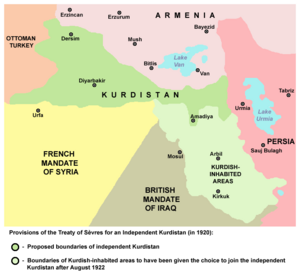
The Kurdistan region, which included Mosul, was supposed to have a vote. This vote would decide its future.
There was no full agreement among Kurdish people about where the borders of Kurdistan should be. This was because Kurdish people lived in many different areas. The treaty outlined a smaller Kurdistan only within what is now Turkey. It did not include Kurds in Iran, British-controlled Iraq, or French-controlled Syria.
The treaty also said that the Assyro-Chaldean minority would be protected. However, this rule was removed in the later Treaty of Lausanne.
Armenia
Armenia was recognized as a "free and independent" state. The treaty stated that the borders between Turkey and Armenia would be decided by the President of the United States, Woodrow Wilson. His decision would also cover Armenia's access to the sea.
The treaty also said that the borders between Armenia, Azerbaijan, and Georgia would be decided by direct talks between those countries. If they could not agree, the Allied Powers would decide.
British Mandate for Iraq
The treaty also set up the British Mandate for Iraq. This was decided in April 1920. The right to drill for oil in the region was given to the British-controlled Turkish Petroleum Company (TPC). This company later became the "Iraq Petroleum Company" (IPC) in 1925.
British Mandate for Palestine
The treaty included the main ideas of the British Balfour Declaration about Palestine. This declaration supported the idea of creating a "national home for the Jewish people" in Palestine. However, it also said that the rights of non-Jewish communities and the rights of Jewish people in other countries should not be harmed.
French Mandate for Syria and Lebanon
The French Mandate for Syria and the Lebanon was also decided in April 1920. This area included land between the Euphrates River and the Mediterranean Sea. It covered about 60,000 square miles and had about 3 million people. This area was later divided by the French into four governments. Faisal ibn Husayn, who had been named king of Syria, was removed by the French in July 1920. He later became king of Iraq.
Kingdom of Hejaz
The Kingdom of Hejaz, located on the Arabian Peninsula, was given international recognition. This kingdom had an estimated area of 100,000 square miles and a population of about 750,000. Its main cities were the holy places of Makka and Medina. Before the war, it was part of the Ottoman Empire, but during the war, it became an independent kingdom under British influence.
Why the Treaty Was Abandoned
The Treaty of Sèvres put much harsher rules on the Ottoman Empire than the Treaty of Versailles did on Germany. France, Italy, and Britain had secretly started planning to divide the Ottoman Empire as early as 1915.
The public talks about the treaty lasted more than 15 months. They started at the Paris Peace Conference in 1919 and continued until April 1920. The delay happened because the Allied powers could not agree on everything. This was also linked to what was happening with the Turkish National Movement.
The Treaty of Sèvres was never officially approved by all sides. After the Turkish War of Independence, most of the countries that signed the Treaty of Sèvres instead signed and approved the Treaty of Lausanne in 1923 and 1924.
While the Treaty of Sèvres was still being discussed, the Turkish national movement, led by Mustafa Kemal Pasha, separated from the Ottoman government in Constantinople. They set up a new government in Ankara in April 1920. Mustafa Kemal called on Turks to fight against the Greeks, who were trying to take land that the treaty had given to Greece. This started the Greco-Turkish War (1919–1922), which Turkey won.
Because of this, the Turkish government told the Allied powers that they could not approve the Treaty of Sèvres. Eventually, Mustafa Kemal won the War of Independence. He forced most of the former Allied powers to come back to the negotiating table.
Besides Mustafa Kemal's armed fight in Anatolia, Arabs in Syria did not want French rule. Turks near Mosul attacked the British, and Arabs in Baghdad also fought against British rule. There was also unrest in Egypt.
Later Treaties
During the Turkish War of Independence, the Turkish Army successfully fought against Greek, Armenian, and French forces. They secured independence for a territory similar to modern-day Turkey.
The Turkish national movement also made its own international agreements. These included the Treaty of Moscow with Soviet Russia in 1921. They also signed the Accord of Ankara with France, ending the Franco-Turkish War. The Treaty of Alexandropol was signed with the Armenians, and the Treaty of Kars set the eastern borders.
A conflict with Britain over the neutral zone of the Straits was avoided in September 1922. This led to the Armistice of Mudanya in October. This agreement brought the former Allied powers back to talks with the Turks in November 1922.
These talks led to the Treaty of Lausanne in 1923. This treaty replaced the Treaty of Sèvres. It gave a large amount of land in Anatolia and Thrace back to the Turks. Under the Treaty of Lausanne, France and Italy only had economic influence, not zones of control. Constantinople was not made an international city, and a demilitarized zone was created between Turkey and Bulgaria.
See also
- Sèvres syndrome
- Paris Peace Conference
- Treaty of Versailles
- Treaty of Saint-Germain-en-Laye
- Treaty of Neuilly-sur-Seine
- Treaty of Trianon
- Minority Treaties
- Sykes–Picot Agreement
- Agreement of Saint-Jean-de-Maurienne




